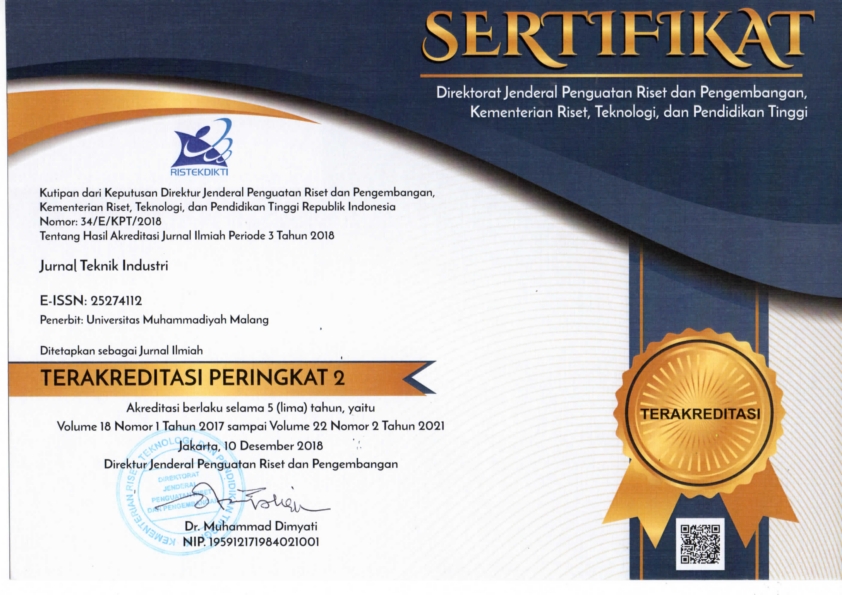Penilaian Risiko Gangguan Musculoskeletal Disorder Pekerja Batik Dengan Menggunakan Metode Strain index
DOI:
https://doi.org/10.22219/JTIUMM.Vol19.No1.97-106Keywords:
Nordic Body Map, Job Strain Index, Musculoskeletal Disorders, BatikAbstract
Workers in batik industry in Indonesia are very big. The process of batik potentially causes interference in the musculoskeletal system (MSDs). This study aims to analyze employee complaints. Methods using Nordic Body Map questionnaires and work risk analysis on hand with Strain Index of batik workers. The result of the research shows that the workers' complaints are upper neck pain and 100% waist pain, upper arm, and back pain are 87.5%, and pain in the lower part of the neck, left shoulder, right shoulder, upper arm right and right hand is 75%. Based on the risk of work with the strain index method obtained results on Manual Pattern Drawing Posture, Posture Drawing Pattern With Ruler, Posture Batik Pattern, Coloring Posture Batik, Posture Coloring Batik Cap and Posture Washing both right hand and left hand classified the work observed dangerous.Downloads
References
S. Wahyuningsih, "Peranan UKM Dalam Perekonomian Indonesia," MEDIAGRO, vol. 5, 2009.
W. Y. Christina, L. Djakfar, and A. Thoyib, "Pengaruh Budaya Keselamatan dan Kesehatan Kerja (K3) terhadap kinerja proyek konstruksi," Rekayasa Sipil, vol. 6, pp. 83-95, 2012.
K. Saddhono, S. T. Widodo, M. T. Al-Makmun, and M. Tozu, "The study of philosophical meaning of batik and kimono motifs to foster collaborative creative industry," Asian Social Science, vol. 10, p. 52, 2014.
R. A. Anugraha, W. Sutan, and I. Mufidah, "The design of batik stamp tool scraping working table using ergonomics principles," Procedia Manufacturing, vol. 4, pp. 543-551, 2015.
L. Punnett and D. H. Wegman, "Work-related musculoskeletal disorders: the epidemiologic evidence and the debate," Journal of electromyography and kinesiology, vol. 14, pp. 13-23, 2004.
S. L. Sauter, L. R. Murphy, and J. J. Hurrell, "Prevention of work-related psychological disorders: A national strategy proposed by the National Institute for Occupational Safety and Health (NIOSH)," American Psychologist, vol. 45, p. 1146, 1990.
K. G. Davis and L. Orta Anés, "Potential of adjustable height carts in reducing the risk of low back injury in grocery stockers," Applied Ergonomics, vol. 45, pp. 285-292, 2014/03/01/ 2014.
B. P. Bernard and V. Putz-Anderson, "Musculoskeletal disorders and workplace factors; a critical review of epidemiologic evidence for work-related musculoskeletal disorders of the neck, upper extremity, and low back," 1997.
W. Sutari, Y. N. D. Yekti, and M. D. Astuti, "Analysis of working posture on muscular skeleton disorders of operator in stamp scraping in ‘batik cap’industry," Procedia Manufacturing, vol. 4, pp. 133-138, 2015.
F. Abdillah, "Analisis postur kerja dengan metode Rapid Upper Limb Assesment (RULA) pada pekerja kuli angkut buah di Agen Ridho Illahi Pasar Johar Kota Semarang," Jurnal Kesehatan Masyarakat Universitas Diponegoro, vol. 2, 2013.
M.-È. Chiasson, D. Imbeau, K. Aubry, and A. Delisle, "Comparing the results of eight methods used to evaluate risk factors associated with musculoskeletal disorders," International Journal of Industrial Ergonomics, vol. 42, pp. 478-488, 2012.
K. Knox and J. S. Moore, "Predictive validity of the Strain Index in turkey processing," Journal of occupational and environmental medicine, vol. 43, pp. 451-462, 2001.
E. Lee, A. Rafiq, R. Merrell, R. Ackerman, and J. Dennerlein, "Ergonomics and human factors in endoscopic surgery: a comparison of manual vs telerobotic simulation systems," Surgical endoscopy and other interventional techniques, vol. 19, pp. 1064-1070, 2005.
N. Rucker and J. S. Moore, "Predictive validity of the strain index in manufacturing facilities," Applied occupational and environmental hygiene, vol. 17, pp. 63-73, 2002.
S. Bao, N. Howard, P. Spielholz, and B. Silverstein, "Quantifying repetitive hand activity for epidemiological research on musculoskeletal disorders–Part II: comparison of different methods of measuring force level and repetitiveness," Ergonomics, vol. 49, pp. 381-392, 2006.
T. Jones and S. Kumar, "Comparison of ergonomic risk assessments in a repetitive high-risk sawmill occupation: Saw-filer," International Journal of Industrial Ergonomics, vol. 37, pp. 744-753, 2007.
J. M. Cabeças, "The risk of distal upper limb disorder in cleaners: A modified application of the Strain Index method," International journal of industrial ergonomics, vol. 37, pp. 563-571, 2007.
S. Bao, P. Spielholz, N. Howard, and B. Silverstein, "Application of the Strain Index in multiple task jobs," Applied Ergonomics, vol. 40, pp. 56-68, 2009.
J. O. Crawford, "The Nordic musculoskeletal questionnaire," Occupational medicine, vol. 57, pp. 300-301, 2007.
J. Steven Moore and A. Garg, "The strain index: a proposed method to analyze jobs for risk of distal upper extremity disorders," American Industrial Hygiene Association Journal, vol. 56, pp. 443-458, 1995.
G. A. Moore and J. M. Fabis, Inside the tornado: marketing strategies from Silicon Valley's cutting edge vol. 19: HarperBusiness New York, 1995.











